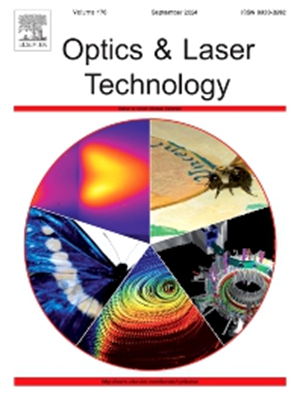IF 4.6
2区 物理与天体物理
Q1 OPTICS
引用次数: 0
摘要
增益介质的热效应对实现高功率、高光束质量的激光器造成了极大的限制。梯度掺杂晶体可以有效缓解热效应。我们使用自生长梯度掺杂晶体,并采用多种策略组合,包括扩散键合端盖、泵浦光束尺寸优化和热效应补偿,以减轻晶体在高功率工作下的热效应。使用键合梯度掺杂(0 at.% + 0.17-0.38 at.%)Nd:YAG晶体,实现了高亮度、高转换效率和高稳定性激光输出,在 2 kHz 重复频率下平均功率高达 12 W,峰值功率为 882 kW。光束质量为 Mx2=1.240 和 My2=1.251 ,功率不稳定性为 0.31 %(有效值)。据我们所知,这是在近衍射限制条件下,端泵单杆 Nd:YAG 激光器达到的最高峰值功率,亮度达到 5.02 × 1013 W/(cm2-Sr)。本文章由计算机程序翻译,如有差异,请以英文原文为准。
High-performance electro-optically Q-switched 2-kHz Nd:YAG laser with optimized gradient dopant concentration and thermal effects improvement
The thermal effects of the gain medium impose significant constraints on achieving high-power high-beam-quality lasers. Gradient-doped crystals can effectively mitigate thermal effects. We use self-grown gradient-doped crystals, and adopt a combination of multiple strategies including diffusion-bonded end caps, pump beam size optimization, and thermal effects compensation, to mitigate the thermal effects of the crystals under the high-power operation. A high-brightness, high-conversion-efficiency, and high-stability laser output is achieved, with an average power up to 12 W at a repetition rate of 2 kHz using a bonded gradient-doped (0 at.% + 0.17–0.38 at.%) Nd:YAG crystal, which corresponds to a peak power of 882 kW. The beam quality is and , and the power instability is 0.31 % (RMS). To the best of our knowledge, this is the highest peak power achieved under near-diffraction-limited conditions for an end-pumped single-rod Nd:YAG laser, with a brightness reaching 5.02 × 1013 W/(cm2·Sr).
求助全文
通过发布文献求助,成功后即可免费获取论文全文。
去求助
来源期刊
CiteScore
8.50
自引率
10.00%
发文量
1060
审稿时长
3.4 months
期刊介绍:
Optics & Laser Technology aims to provide a vehicle for the publication of a broad range of high quality research and review papers in those fields of scientific and engineering research appertaining to the development and application of the technology of optics and lasers. Papers describing original work in these areas are submitted to rigorous refereeing prior to acceptance for publication.
The scope of Optics & Laser Technology encompasses, but is not restricted to, the following areas:
•development in all types of lasers
•developments in optoelectronic devices and photonics
•developments in new photonics and optical concepts
•developments in conventional optics, optical instruments and components
•techniques of optical metrology, including interferometry and optical fibre sensors
•LIDAR and other non-contact optical measurement techniques, including optical methods in heat and fluid flow
•applications of lasers to materials processing, optical NDT display (including holography) and optical communication
•research and development in the field of laser safety including studies of hazards resulting from the applications of lasers (laser safety, hazards of laser fume)
•developments in optical computing and optical information processing
•developments in new optical materials
•developments in new optical characterization methods and techniques
•developments in quantum optics
•developments in light assisted micro and nanofabrication methods and techniques
•developments in nanophotonics and biophotonics
•developments in imaging processing and systems

 求助内容:
求助内容: 应助结果提醒方式:
应助结果提醒方式:


